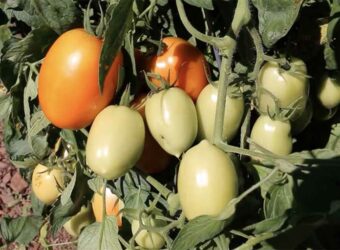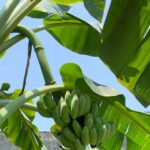Banana plants are tropical plants from Asia. They are now grown in tropical areas all over the world. In colder areas, bananas can be grown indoors.
Important Banana Facts
| Scientific Name | Musa acuminata and Musa balbisiana |
| Type of plant | Perennial |
| Part Eaten | fruit |
| Days to Harvest | 10-20 months |
| Season Grown | All seasons |
| Cooked or raw | both |
| Optimal pH | 5.5-7.0 |
| Germinate at | 78 F |
| Optimal Temperature for growth | 78-82 F |
There are two species of banana trees that are commonly grown. Although people refer to banana trees, bananas are actually herbaceous perennials.
The ‘tree trunk’ is actually a woody stem. The banana tree is formed of sheaths of leaves growing from a corm, or underground rhizome. The plant has berries, which we call fruit, at ten to twenty months.
Bananas are tropical plants that will stop growing at 50 F and do not tolerate frost. They may be grown indoors as ornamental plants or in areas where it is too cold for them to overwinter.
The variety ‘Dwarf Cavendish’ is six feet tall and will produce bananas when grown indoors. The variety ‘Lady Fingers’ is also grown indoors for bananas. Some people treat bananas grown for ornamental purposes as annuals, starting with new plants each spring.
The 6 Banana Growth Stages
| Growth Stage | Days after Planting For the Stage to Start* |
|---|---|
| Division | 0 |
| Vegetative growth | 0 |
| Flowering | 10 to 15 months |
| Fruiting | 10-15 months |
| Harvest | 9 to 20 months |
| Renovation | After Harvest |
*The exact time depends on the variety.
Starting A Banana Tree
Most banana trees grown for the fruit do not have seeds, so are propagated from shoots off the mother plant. These shoots are cut off the rhizome with a sharp shovel or knife and planted. A few banana varieties have seeds, but they are rarely available to the home gardener.
Plant the banana shoot in a pot or outside if your area has winters that do not get colder than about 35 degrees F. The banana rhizome is planted in a hole four inches deep. Space the plants at least ten feet apart. Each rhizome and the plants that grow from it are called a mat.
Growing the Pseudostem
When banana plants grow, what we consider the tree is actually called a pseudostem and is made of the concentric sheaves of leaves. The leaves can be up to six feet long. As each leaf ages and falls off, the sheath remains to form part of what we call the trunk. Leaves get smaller as the trunk gets taller.
When the banana tree is ten to fifteen months old, the true stem grows up inside the leaf sheaths and comes out the top. It is the top of this structure that has flowers.
Banana Flowers Are Weird
Banana flowers are very odd.
First, flowers appear in groups on the stem, called hands. The flowers are covered by purplish bracts. As the flower stem develops, the bracts of the hand roll up and expose that hand. The first flowers are female and develop into bananas without fertilization in most edible bananas. This is why they do not have seeds. The number of hands of female flowers makes up a bunch and varies from two or three to more than ten.
Next, numerous hands of sterile flowers appear. They shed their bracts but fall off without producing bananas.
Finally, numerous hands of male flowers appear and shed their bracts. They do not have bananas, either. All of this happens rather quickly, with a bract rolling up to expose a new hand of flowers almost every day once the flowers appear.
Banana Fruit Development
The female flowers form on a bud stem. The bananas they bear will be in bunches. The sterile and male flowers leave a long bud stem below the banana bunches when they fall. You can break off the bud stem below the lowest bunch of bananas because it doesn’t have any useful purpose.
While a tropical banana can produce 100 pounds of fruit at a time, most indoor bananas produce 35 to 40 pounds of bananas in bunches of three to eight. The amount of fruit the plant will produce is determined by how well the plant is cared for during the first three to four months of its life.
Bananas require lots of water to make. Banana plants need 1-1.5 inches of water a week in the ground. Inside, keep the soil moist but not soggy. Bananas are very susceptible to rotting when the soil is too moist, so you need to walk a tightrope between too moist and too dry.
Harvest When Green
Bananas ripen best when they are cut off from the tree when green. When the fruit is plump and rounded, cut the whole stem off. Place it in a cool, shaded place so the fruit can ripen to yellow. As soon as the first banana gets ripe, the rest will quickly follow. You can hasten this by putting the bunch in a paper bag with a sliced apple for 24 hours. Remove it from the bag after that, or the bananas will get too ripe to use.
Renovation of Banana Plant
Once the banana plant has had bananas, it will not flower again.
Usually, there are shoots growing from the rhizome around the mother plant that has the potential to become new banana plants and have bananas. A good practice is to let one banana plant flower, have one half-grown, and have one new one per mat, or rhizome.
When the bananas are harvested, cut the banana plant to the ground and chop it into small pieces. Use the pieces as mulch around the mat. The half-grown plant will then mature and have bananas.
Do not let more than three shoots grow from the mat at the same time, or the plants will be overcrowded. Overcrowded banana plants are stunted and do not produce many bananas. In a pot, you will probably only be able to have two plants at a time– a mature one and a new one.
Storage Instructions
Bananas do not last long. Once ripe, they can be stored in the refrigerator for a few days. The peel will turn black, but the inside will stay good. Bananas are used raw and cooked in a variety of dishes. Frozen bananas are often used to make smoothies. Overripe bananas can be pureed and used in cooking. Green bananas that are full and rounded can be sliced and fried.
Collecting Seeds
Almost all the banana plants available to the home gardener do not have seeds. They are propagated by division.
In conclusion, banana plants are grown for the bananas and as ornamental plants. They are not frost-hardy, so are either grown in very warm climates or grown inside. If you are not growing the plant for the bananas, it can be treated as an annual, and new plants are put in the ground each year. A banana plant has bananas ten to fifteen months after it starts growing. Bananas have the best flavor when they are harvested green and ripened off the tree. A banana tree only flowers once. It should be cut down when the bananas are harvested, and its shoots allowed to grow into new plants.






